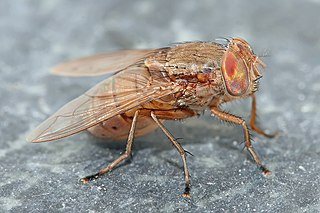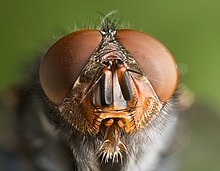
The Calliphoridae are a family of insects in the order Diptera, with almost 1,900 known species. The maggot larvae, often used as fishing bait, are known as gentles. The family is known to be polyphyletic, but much remains disputed regarding proper treatment of the constituent taxa, some of which are occasionally accorded family status.

Cluster flies are flies of the genus Pollenia in the family Polleniidae. Unlike the more familiar blow flies, such as the bluebottle genus Phormia they do not lay eggs in human food. They parasitise earthworms; the females lay their eggs near earthworm burrows, and the larvae then feed on the worms. But the biology of this group is relatively poorly known and a few have been recorded from other hosts including caterpillars and bees.

Bengalia is a genus of blow flies in the family Calliphoridae with one authority considering the genus to belong to a separate family Bengaliidae. These bristly and, unlike the greens and blues of most calliphorids, dull coloured flies, are especially noted for their relationship to ants. Little is known of their biology and life-cycle, although adults of many species are kleptoparasitic on ants and will snatch food and pupae being carried by ants or feed on winged termites. The apt name “Highwayman Fly” was given by an early observer of their way of robbing ants. Very little is known about their breeding habits. The genus is found in the Afrotropical and oriental region with one species from Australia possibly a recent introduction.
The Melanomyinae are a subfamily of Calliphoridae, or blow flies. According to Whitworth, the most distinguishing characteristic of this subfamily is its dull color; however, the biology is poorly known.

The Bengaliinae are a subfamily of Calliphoridae, or blow flies.

Cordylobia is a genus of flies from the family Calliphoridae. The larvae of Cordylobia are parasitic on mammals, especially rodents. Two species, C. anthropophaga and C. rodhaini, also are known as parasites of humans. The adult flies feed on rotting fruits, vegetables, and animal faeces, and are most abundant in the wet season. Like many tropical insects, they are most active in the morning and evening. Cordylobia species are largely confined to Africa, though they have been recorded elsewhere when transported by human travellers.

Andy Z. Lehrer was a Romanian entomologist. From 1996 until his death, he worked as a research associate in the laboratory of Zoology at the University of Tel Aviv in Tel Aviv, Israel. For several years, he studied flesh flies and blow flies from all over the world.
Verticia is a genus of flies (Diptera) in the family Calliphoridae. The genus was first described by J.R. Malloch in 1927.

Polleniidae is a family of flies in the order Diptera. There are at least 6 genera and more than 190 described species placed definitively in Polleniidae, and other genera whose placement here is considered uncertain. The largest genus is Pollenia, with close to 190 species of flies commonly called "cluster flies".
Pollenia dysaethria is a species of cluster fly in the family Polleniidae.
Pollenia oreia is a species of cluster fly in the family Polleniidae.
Pollenia agneteae is a species of cluster fly in the family Polleniidae.
Pollenia alajensis is a species of cluster fly in the family Polleniidae.
Pollenia bartaki is a species of cluster fly in the family Polleniidae.
Pollenia bezziana is a species of cluster fly in the family Polleniidae.
Pollenia griseotomentosa is a species of cluster fly in the family Polleniidae.
Pollenia japonica is a species of cluster fly in the family Polleniidae.
Pollenia mesopotamica is a species of cluster fly in the family Polleniidae.
Pollenia ponti is a species of cluster fly in the family Polleniidae.
Dexopollenia is a genus of flies in the family Polleniidae.







